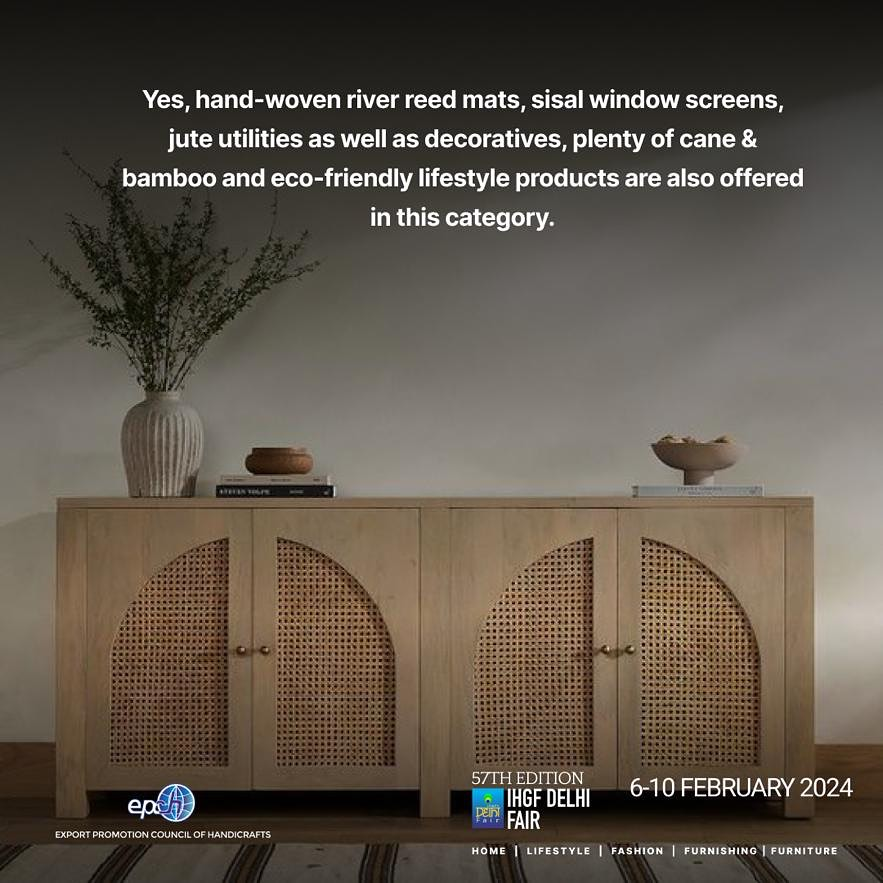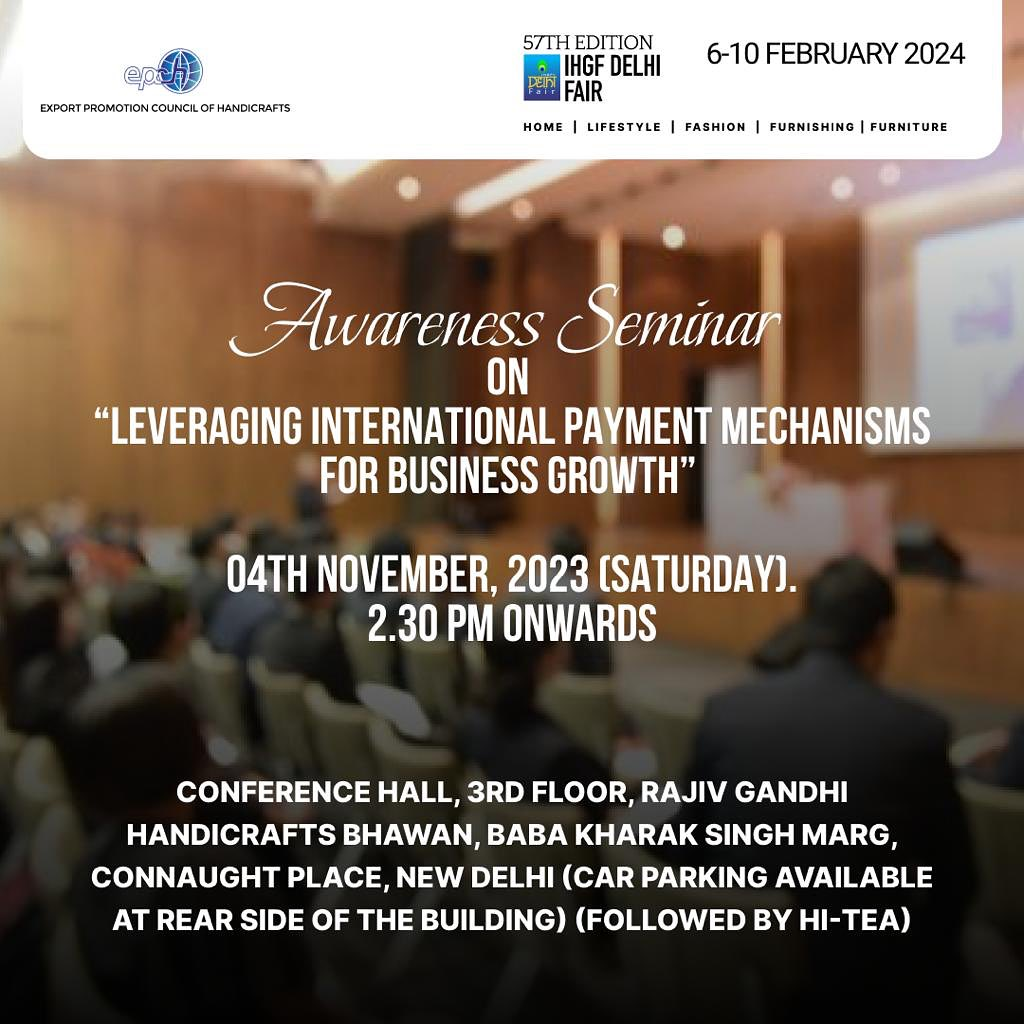Eco-Friendly Products Fair in 2024
In a world that is increasingly becoming aware of the environmental challenges it faces, the need for sustainable practices has never been more crucial. The year 2024 brings forth an inspiring event that echoes the spirit of eco-consciousness – the Eco-Friendly Handicraft Products Fair.

This fair is not just a congregation of artisans and craftsmen but a testament to the growing global movement towards sustainable living and responsible consumption. In this comprehensive exploration, we delve into the significance of such events, the impact they have on local economies, and how they contribute to a more sustainable and environmentally conscious future.
The Rise of Eco-Friendly Handicrafts
Handicrafts have been an integral part of human history, reflecting diverse cultures and traditions. However, as the world grapples with environmental issues, there is a growing shift towards eco-friendly alternatives in every aspect of life, including handicrafts. The use of sustainable materials, ethical production processes, and environmentally friendly packaging are becoming key considerations for both artisans and consumers.

This shift is not merely a trend but a paradigm shift in the way we approach craftsmanship and consumption. The Eco-Friendly Handicraft Products Fair of 2024 serves as a platform to showcase and celebrate the innovation and creativity of artisans who are committed to crafting products that leave a minimal ecological footprint.
The Impact of Eco-Friendly Handicrafts on Local Economies
One of the remarkable aspects of the Eco-Friendly Handicraft Products Fair is its positive impact on local economies. By promoting traditional craftsmanship that utilizes sustainable materials, the fair empowers local artisans, creating economic opportunities within communities. This not only preserves cultural heritage but also fosters a sense of pride and identity among craftsmen.

Moreover, the fair provides a unique avenue for small-scale artisans to access larger markets. Through networking and exposure gained at such events, these artisans can establish connections with retailers and consumers who are increasingly seeking sustainable products. This, in turn, contributes to the economic development of the regions where these artisans reside.

The fair acts as a catalyst for sustainable entrepreneurship, encouraging artisans to adopt eco-friendly practices not only for ethical reasons but also for economic viability. As consumers become more conscientious about their purchasing decisions, there is a growing demand for products that align with environmental values. The Eco-Friendly Handicraft Products Fair becomes a bridge connecting conscious consumers with artisans who share their commitment to sustainability.
Innovations in Eco-Friendly Handicrafts
The fair is not just a showcase; it is a breeding ground for innovation. Artisans from around the world come together to exchange ideas, techniques, and experiences in creating eco-friendly handicrafts. This cross-pollination of ideas leads to the emergence of new and innovative products that marry traditional craftsmanship with modern sustainability practices.

For example, artisans may experiment with upcycling – transforming discarded materials into high-quality handicrafts. This not only reduces waste but also adds a unique narrative to the products. Similarly, the use of renewable materials such as bamboo, organic cotton, and recycled metals is explored, highlighting the versatility and potential of sustainable resources.

In addition to materials, the fair also explores sustainable production processes. Artisans may adopt low-impact techniques, such as natural dyeing methods, energy-efficient manufacturing, and water conservation practices. These innovations not only reduce the environmental footprint of the products but also contribute to the overall sustainability of the handicraft industry.
Educational Initiatives and Workshops
A key aspect of the Eco-Friendly Handicraft Products Fair is its commitment to education and awareness. Workshops, seminars, and interactive sessions are organized to inform both artisans and consumers about the importance of eco-friendly practices. These initiatives aim to bridge the gap in understanding and provide practical insights into incorporating sustainability into the handicraft industry.

Artisans benefit from these workshops by gaining knowledge about the latest sustainable practices, certifications, and market trends. This empowers them to make informed decisions about their craft, ensuring that they remain competitive in an evolving market that values sustainability.

On the consumer side, educational initiatives raise awareness about the environmental impact of consumer choices. Understanding the journey of a product – from raw materials to finished handicraft – allows consumers to make more conscious decisions. By fostering a sense of responsibility, the fair contributes to the larger goal of creating a consumer base that values quality over quantity and sustainability over convenience.
Promoting Cultural Diversity
While the focus of the fair is on eco-friendly practices, it also serves as a celebration of cultural diversity. Traditional handicrafts are deeply rooted in the cultural heritage of communities around the world. The fair provides a stage for artisans to showcase their unique cultural expressions through their crafts.

From intricate handwoven textiles to delicately carved wooden artifacts, the fair is a kaleidoscope of cultural richness. This celebration not only preserves traditional art forms but also fosters cross-cultural appreciation. Visitors to the fair are exposed to a plethora of artistic traditions, creating a global tapestry of creativity that transcends borders.

Furthermore, the fair encourages collaborations between artisans from different cultural backgrounds. These collaborations often result in the fusion of diverse artistic styles, leading to the creation of hybrid handicrafts that carry the essence of multiple cultures. This cross-pollination not only produces aesthetically rich products but also fosters understanding and harmony among communities.
Addressing Environmental Challenges
In addition to showcasing eco-friendly products, the fair takes a proactive stance in addressing environmental challenges. Panel discussions, forums, and keynote addresses by experts in environmental sustainability provide a platform for dialogue and knowledge exchange.

Topics such as climate change, deforestation, and pollution are discussed in the context of the handicraft industry. This holistic approach aims to create awareness about the broader environmental issues that impact both artisans and consumers. By fostering a sense of responsibility, the fair encourages participants to consider the long-term environmental consequences of their choices and actions.

Moreover, the fair explores ways in which the handicraft industry can actively contribute to environmental conservation. This may involve initiatives such as tree planting campaigns, waste reduction programs, or collaborations with environmental organizations. By aligning the industry with environmental stewardship, the fair sets a precedent for other sectors to follow suit.
Networking Opportunities for Artisans
One of the invaluable aspects of the Eco-Friendly Handicraft Products Fair is the networking opportunities it provides for artisans. Traditionally, many artisans, especially those from remote or economically disadvantaged regions, face challenges in reaching wider markets. The fair serves as a bridge, connecting these artisans with retailers, distributors, and even fellow craftsmen.

The networking opportunities extend beyond the duration of the fair. Artisans often establish long-lasting connections that result in ongoing collaborations and partnerships. This not only benefits individual artisans but also contributes to the overall growth and sustainability of the handicraft industry.

Collaborations may take various forms, from joint ventures in production to co-hosting workshops and exhibitions. Such partnerships not only enhance the visibility of artisans but also facilitate the exchange of skills and knowledge. This collaborative spirit is a powerful driver for positive change within the handicraft community.
Consumer Empowerment and Conscious Choices
The fair is not just a marketplace; it is an arena for empowering consumers to make conscious choices. As consumers become increasingly aware of the environmental impact of their purchases, they seek products that align with their values. The fair provides a curated selection of eco-friendly handicrafts, allowing consumers to make informed decisions about the products they bring into their homes.

Through interactions with artisans and educational initiatives, consumers gain insights into the craftsmanship and the story behind each product. This transparency creates a sense of connection between the consumer and the artisan, fostering a deeper appreciation for the value of handmade, eco-friendly products.

Moreover, the fair encourages consumers to adopt a more mindful approach to consumption. By emphasizing the quality, durability, and timeless appeal of handicrafts, the fair challenges the prevailing culture of disposable and mass-produced goods. This shift towards conscious consumption not only benefits the environment but also contributes to the well-being of artisans who produce goods with care and dedication.
Conclusion
The Eco-Friendly Handicraft Products Fair of 2024 stands as a beacon of hope and inspiration in a world grappling with environmental challenges. It goes beyond being a mere exhibition; it is a movement that champions sustainability, celebrates cultural diversity, and empowers both artisans and consumers. The fair not only provides a platform for the showcase of eco-friendly handicrafts but also fosters a community of like-minded individuals committed to making a positive impact on the planet.

As the world continues to navigate the complex landscape of environmental issues, initiatives like the Eco-Friendly Handicraft Products Fair play a pivotal role in shaping a more sustainable and conscious future. Through collaboration, innovation, and education, this fair contributes to the ongoing global effort to create a world where craftsmanship and environmental stewardship coexist harmoniously.
Comments
Post a Comment